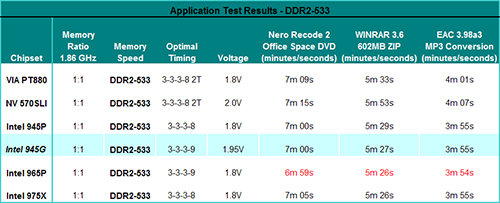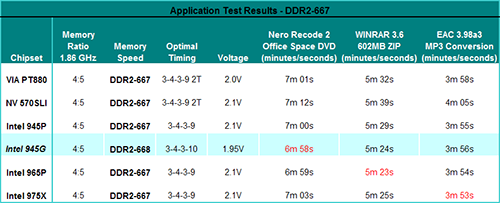ASRock ConRoe945G-DVI: Core 2 Duo goes mATX
by Gary Key on September 1, 2006 5:15 AM EST- Posted in
- Motherboards
Application Performance
We decided to test a few real world applications that typically stress the CPU, memory, and storage systems to see if the results from our synthetic memory tests carry over to the desktop.
Our tasks include three activities that are common on the desktop. Our first test was to measure the time it takes to shrink the entire Office Space DVD that was extracted with AnyDVD into a single 4.5GB DVD image utilizing Nero Recode 2. Our second test utilizes WinRAR 3.6 and measures the time it takes to compress our test folder that contains 444 files, 10 folders, and has 602MB of data.
Our third test uses Exact Audio Copy as the front end for our version 3.98a3 of LAME. We set up EAC for variable bit rate encoding, burst mode for extraction, use external program for compression, and to start the external compressor upon extraction. (EAC will read the next track while LAME is working on the previous track, thus removing a potential bottleneck with the optical drive.) Our test CD is INXS Greatest Hits, which contains 16 tracks totaling 606MB of songs. The results of our tests are presented in minutes/seconds with lower numbers being better.
Our application test results mirror those of the synthetic results where the ASRock 945G scored well in both the buffered and unbuffered Sandra benchmarks along with the SuperPI 2M test. This chipset scored at the top of the DDR2-533 and DDR2-667 tests. You will want to run this board at either memory setting with low latency memory for best performance, but it will cost less to find DDR2-533 memory that can run at these settings with the memory voltage limitation. We believe the BIOS on this board is tuned better than the ASRock 945P board as in past testing we found the 945P to be a better performing chipset.
We decided to test a few real world applications that typically stress the CPU, memory, and storage systems to see if the results from our synthetic memory tests carry over to the desktop.
Our tasks include three activities that are common on the desktop. Our first test was to measure the time it takes to shrink the entire Office Space DVD that was extracted with AnyDVD into a single 4.5GB DVD image utilizing Nero Recode 2. Our second test utilizes WinRAR 3.6 and measures the time it takes to compress our test folder that contains 444 files, 10 folders, and has 602MB of data.
Our third test uses Exact Audio Copy as the front end for our version 3.98a3 of LAME. We set up EAC for variable bit rate encoding, burst mode for extraction, use external program for compression, and to start the external compressor upon extraction. (EAC will read the next track while LAME is working on the previous track, thus removing a potential bottleneck with the optical drive.) Our test CD is INXS Greatest Hits, which contains 16 tracks totaling 606MB of songs. The results of our tests are presented in minutes/seconds with lower numbers being better.
 |
 |
| Click to enlarge |
Our application test results mirror those of the synthetic results where the ASRock 945G scored well in both the buffered and unbuffered Sandra benchmarks along with the SuperPI 2M test. This chipset scored at the top of the DDR2-533 and DDR2-667 tests. You will want to run this board at either memory setting with low latency memory for best performance, but it will cost less to find DDR2-533 memory that can run at these settings with the memory voltage limitation. We believe the BIOS on this board is tuned better than the ASRock 945P board as in past testing we found the 945P to be a better performing chipset.










33 Comments
View All Comments
passport - Wednesday, September 13, 2006 - link
With this board in order to overclock higher than 299 you either have to do the CPU,PCIE Sync which will allow you to go up to about 130-320 before you knacker your SATA drives or you can set it to CPU,PCIE Async; set PCIE to 117 (no effect on system) and then you are able to go up to 350 (runs a 6400 @ 2.8 gHZ). Don't forget that at these speeds you are also overclocking your memory so open up the timings before you try it.RomanMtz - Wednesday, September 13, 2006 - link
Hello... I plan on using this budget board as a transition board until the Lanparty series for Conroe is released or more OCing board options arise. My only concern is that, while I will probably use it stock with a E6600, I want to make sure my Geforce 7950GX2 fits in it. I read the Epox 945 MATX review on Hard and they mentioned that that card did not physically fit in that board. Any comments about this would be greatly appreciated. Thanks!deathwalker - Tuesday, September 5, 2006 - link
Are the overclocking shortcommings of this board (cpu core vlt/memory vlt)correctable thru possible future bios updates?JarredWalton - Tuesday, September 5, 2006 - link
Possibly, but I wouldn't count on ASRock making the changes. Most of their boards have the same BIOS limitations and have for a while now. :|deathwalker - Tuesday, September 5, 2006 - link
I sure home ASUS gets there P5B-VM to the market place soon. I want to get my hand on a good MicroAtx Core 2 Duo board so I can upgrade my Ultra Fly SFF system.roman2 - Tuesday, September 5, 2006 - link
I have bought a pretty similar board recently - Asus P5LD2-VM SE. It is a stripped-down board, but for a real bargain. I also have Core2 E6400 (8x, 2.13GHz, step.B2) and 2x1GB Corsair XMS2 675MHz-CL4.I've been trying to overclock this configuration and was able to reach 297 MHz FSB stable (2.37GHz CPU, 742MHz 4-4-4-12 memory, both stock voltage). The board has quite good CPU/memory voltage setting capabilities, but I wasn't able to post after 299 MHz. Any suggestions?
What is the best memory timing for these Corsair modules at such a high frequency?
What is the maximum safe voltage for CPU and what for the memory? (I didn't try to push the voltage much higher to not destroy the thing).
I have the board for a month now, for a month overclocked and must say it was worth it. But if I could achieve even higher overclock, it would be really nice :-)
PotatoMAN - Sunday, September 3, 2006 - link
Thanks again AT. I always enjoy reading your articles and they usually have most of what I am looking for. Like others before my post, I too want to see power consumption. I am looking for a solution to put in my car as I will be fabricating a carputer in the coming months. Seeing as how I expect the Core Duo to last, and I don't want to upgrade my carputer for years to come, this probably will be the solution pending the power consumption of the mainboard coupled with the CPU. It would be nice to get some comparison along with the Centrino line processors, as well =)kmmatney - Friday, September 1, 2006 - link
Although the DVI riser card is a great idea (and gives the the possibility of dual monitors) it seems like the sensible thing to do would be to have a DVI connector as the standard on-board connector. You can always use a DVI-to-VGA adapter if necessary, and those must be cheaper than the riser card. Anybody with enough cash to go dual-screen can buy another cheap card, or better yet, a card with dual DVI output.agent2099 - Friday, September 1, 2006 - link
I know most of us interested in mATX boards are especially interested if a board includes two particular things:Component video output (for onboard video)
SPDIF audio output
Future roundups should include whether or not a board has these features.
yyrkoon - Friday, September 1, 2006 - link
Well, owning an Asrock motherboard I feel compelled to speak up on the subject. While my motherboard is an Asrock AM2NF4G-SATA2, I have a feeling the feature set (minus the DVI card) is probably pretty much the same. After one months times of owning this board, I would have to say that it is a well thought out board in most respects.However, that being said, there is a few things of concern relating to this board as well.1) As stated in this article, The Asrock AM2NF4G-SATA also has limited memory, and vcore adjustments, which is probably to be expected in a budget motherboard. I was however able to eek out a 16% OC by dropping the multiplier to 11x, and raising the HT to 250MHZ. Raising it any higher caused system instabilities. Dropping the multiplier further resulted in a lower OC, which I felt wasnt worth the time playing around with.
2) Setting up a SATA as the boot disk on these motherboards seems to be borderline un-exceptable. First, you must go into the BIOS, and change the SATA operation mode to [RAID], enter into the RAID BIOS utility, identify, and set the drive as a 'spanning' (JBOD) array, and THEN either have a driver slipstreamed copy of XP, or have a floppy attached. To make matters worse, these steps are not in the manual, and after talking to technical support on the phone (email technical support is shyte, until you get an actual email address from a rep), it took me several hours of trial and error, to figure out the proceedure. Another thing to note, is that these steps must be followed if you expect to run XP setup with a SATA attached period, whether its the boot disk, or not, otherwise you'll have to disconnect the drive, and re-attach it afterwords.
3) Stability seems to be an issue on this system, although, this could be attributed to software, I'm still trying to iron out the details (yes, after a month). Its hard tracing the problem since the system seems to randomly reboot, once every 2-3 days, and its a hard reboot, with no BSoD. I suppose this problem COULD be related to another peice of hardware, I'll have to figure that out.
Anyhow, I would like to know if the problems (except for #1) I've experienced with my motherboard, hold true for this motherboard as well. I would like to add, that for the price, this motherboard is probably well worth it, once you get used to the odd behavior, and realize that this motherboard wont OC very well (should be known to begin with anyhow), it could prove to be a decent motherboard. I'll just have to keep testing the stability issues of my own, and on a clean XP Pro install, so far (in about 18 hours) no random reboots.